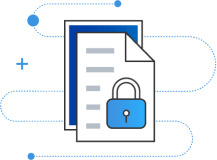Today, the number of separate tools that IT and Security teams use for data protection and privacy risk range from data discovery, classification, DLP, EDRM, EPP, and CASB. This patchwork of use case and silo-specific security controls are creating new complexities for organizations and increased risk to sensitive data including:
Managing rules sets in these tools in isolation fosters inconsistent policies that expose data
Integration of disparate solutions is difficult to implement and leads to excessive total cost of ownership
Multiple consoles and alert tools create operational complexity and often overwhelm the ability to administer and respond in a timely fashion
Fasoo Data Security Platform helps organizations enable data security posture management (DSPM) to identify potential risks and vulnerabilities, implement proper security controls, and maintain data visibility throughout its entire lifecycle.

Fasoo overcomes these complexities with its industry leading Data Security Platform. Fasoo combines disparate data security capabilities into a purpose-built, highly automated, centrally managed, data-centric platform. Organizations secure their data better and more easily with Fasoo.

Critical Data-Centric Processes

Automation

Centralized Policies

Critical Data-Centric Processes
Traditional DLP solutions lack essential capabilities to address today’s hybrid workplace, emerging privacy demands and Zero Trust standards. Fasoo’s integrated data-centric processes address today’s challenges by including:

Automation
Freeing user’s from security responsibilities eliminates errors and sustains workflow productivity. Fasoo’s DSP is highly automated and sequences previously time-consuming interactions into a single transparent flow.

Centralized Policies
Consistent policies managing all data-centric processes is essential for the persistent safeguarding of sensitive data. Fasoo’s DSP provides administrators centralized control over their entire unstructured data inventory, no matter where it resides.



Product Overview
Map your data landscape, identifying structured and unstructured data across on-prem, cloud, and SaaS.

Product Brochure
Evaluate security risks by analyzing access controls and repository vulnerabilities while uncovering unmanaged data.

Product Overview
Protect, control, and track sensitive data persistently with a robust file-centric protection and granular access permission control.

Product Overview
Enhance your traditional data loss prevention(DLP) technologies with data discovery and classification and comply with CPRA, CPA, GDPR.

Product Overview
Collect and monitor all Fasoo-protected documents usage logs to assess, analyze, and optimize data security poicies.
A data security platform is a comprehensive solution that enables organizations to protect their sensitive data from unauthorized access, use, and disclosure. It typically includes a range of security technologies and tools, such as encryption, access controls, threat detection and response, data loss prevention, and security analytics. A data security platform provides organizations with a centralized and integrated approach to data protection, allowing them to manage their data security needs more efficiently and effectively. It also enables organizations to comply with data privacy and security regulations, such as the General Data Protection Regulation (GDPR) and the California Consumer Privacy Act (CCPA), by providing the necessary controls and safeguards to protect personal and sensitive data. By implementing a data security platform, organizations can reduce the risk of data breaches and cyber-attacks, protect their brand reputation, and maintain the trust of their customers and stakeholders. It can also provide insights into how data is being used across the organization, enabling better decision-making and risk management. Overall, a data security platform is an essential tool for any organization looking to protect its sensitive data and maintain a strong security posture.
Data-centric security is an approach to cybersecurity that focuses on protecting data itself, rather than just securing the systems or networks that store or transmit it. The goal of data-centric security is to ensure that data remains secure throughout its lifecycle, from creation to deletion, regardless of where it is stored or transmitted. Data-centric security typically involves implementing security controls and techniques, such as encryption, access controls, data masking, and tokenization, to protect data at rest, in transit, and in use. This helps prevent unauthorized access, modification, and disclosure of sensitive data, and ensures that data remains secure even if it is stolen or compromised. The benefits of data-centric security include greater control over data, improved compliance with data privacy and security regulations, and reduced risk of data breaches and cyber-attacks. It also enables organizations to focus on protecting their most valuable asset – their data – rather than just securing the systems and networks that store or transmit it.
Data security posture management (DSPM) refers to the process of assessing, maintaining, and improving an organization’s overall data security posture. It involves evaluating the effectiveness of data security controls, policies, and procedures to ensure that data is adequately protected from unauthorized access, use, or disclosure. DSPM involves several key activities: Risk Assessment, Security Control Assessment, Compliance Monitoring, Incident Response Planning, and Continuous Monitoring.